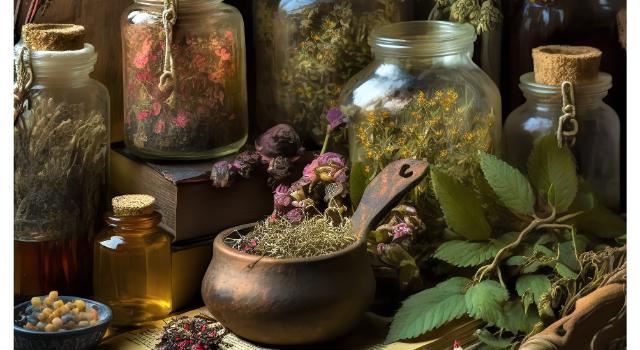When we want to incorporate herbs into our everyday life, there are a few different ways to enjoy them; fresh harvest from the garden, herbal infusions (tea) and herbal tinctures. Our goal at Urban Moonshine is to get more people comfortable using plant medicines in their daily lives, and to enjoy the many versatile ways of using tinctures in particular! Here are our tips on how to take a tincture, and why this form may be the best option for you…
What are herbal tinctures?
Herbal Tinctures, like our digestive bitters, are liquid extracts made from herbs that you take orally (by mouth). Tinctures are preparations that use something other than water as a solvent. Using a solvent like alcohol, vinegar, or glycerin, you can extract a more considerable amount of the medicinal constituents of the plant and preserve those constituents much longer than you can with loose herbs, or powder. Alcohol is the traditional way of making tinctures and also acts as an effective preservative.
Herbal tinctures are long-lasting–about 3 years–and preserve the freshness and potency of medicinal plants. Alcohol-based tinctures have a long shelf life if stored in a cupboard or out of direct sunlight and refrigeration is not necessary to enhance the properties of your food. For bitter herbs we suggesting taking them alone or in a small amount of water to get the benefits from the bitter flavor. One of the reasons we find herbal tinctures to be so convenient is that they are a quick and easy way to get herbs into your body. Not to mention that they make it easy to take your health practices on the go; while at work, vacation, etc.
As herbalists, we measure time through plants and their life cycles. The magic of tinctures is that even after the last harvest in the fall–the plant’s medicinal qualities and spirit live on through the ways we preserve them. Throughout the cycle of the year, we can still taste the freshness and of our herbs when they are in tincture form.
Common questions we get about tinctures:
How long does it take for a tincture to have an effect?Depending on the herb, some tinctures will have an effect more quickly, such as those made with aromatic herbs like motherwort, or lemon balm, often used to help you relax. Others that are more nutritive and building (adaptogenic herbs- which support your body’s natural resilience to stress over time) may take several weeks of consistent use before you notice their effects.*
How many drops of tincture should I take, and how often: Because it’s a concentrate, you don’t need that much. 1/4 to 1 tsp is usually enough. Some herbal tinctures can be taken up to a few times a day. For bitters, we suggest 5-10 minutes before meals, and for them to be taken undiluted as is–the point is to taste the bitter flavors so that our digestive system responds. Diluting the flavor in water or tea won’t have the desired effect.
For aromatic tinctures like our Joy Tonic–we suggest up to 3x/day as is, or added into teas, water bottles or sparkling water as needed. Always follow the dosing directions on the packaging and consult your healthcare provider before use if you are pregnant, nursing, or have any other health condition.
I’m not down with the use of alcohol…There is actually a very low amount of alcohol in each serving when you consider the dose of the product and the percentage alcohol. 1/4 tsp of the bitters at 30-35% alcohol is about 1/12th of tsp alcohol (8.333…% of the serving size, or 0.41 mL ethanol)–comparable to what’s found in a 16 oz pint of kombucha at 2.4 mL ethanol.
Most kombucha brands on shelves today contain just a fraction of alcohol–less than .5% ABV–allowing them to be sold as non-alcoholic beverages under the guidelines of the Alcohol and Tobacco Tax and Trade Bureau.
Think of tinctures like vanilla extract or a kombucha–not an alcoholic beverage!
For your reference:
0.5% ethanol for 16 oz kombucha = approx. 2.4 mL ethanol.
UM Joy Tonic is 48% ethanol, 5mL/dose = 2.4 mL ethanol.
UM Original bitters is 35% ethanol, 1.2mL/dose = 0.42 mL ethanol.
A pint of kombucha contains the same amount of ethanol as a dose of Joy Tonic.
A pint of kombucha has more than 5x the amount of alcohol as a dose of bitters.
Note: When dosing for recipes using tonic herbal tinctures (adaptogens or Immune Tonic) we take the average yield per serving and add a dose of each tincture for each return. Example: Makes 20 snack balls–add in 20 servings of Simmer Down Tonic. We do not recommend using bitters in recipes like this, and instead be taken in just a little bit of water (an inch or so in the bottom of a glass) or undiluted in order to fully activate the tongue’s bitter taste receptors, for maximum effectiveness.
sources:
Rrd. “Kombucha Information and Resources.” TTB | Beer | Brewers Qualification, www.ttb.gov/kombucha/kombucha-general.shtml.
27 CFR 7.71 – Alcoholic content. (n.d.). Retrieved from https://www.law.cornell.edu/cfr/text/27/7.71
Electronic Code of Federal Regulations, PART 7—LABELING AND ADVERTISING OF MALT BEVERAGES, Subpart H §7.71 Alcoholic content
(e) Non-alcoholic. The term “non-alcoholic” may be used on malt beverages, provided the statement “contains less than 0.5 percent (or .5%) alcohol by volume” appears in direct conjunction with it, in readily legible printing and on a completely contrasting background. (f) Alcohol free. The term “alcohol free” may be used only on malt beverages containing no alcohol.


